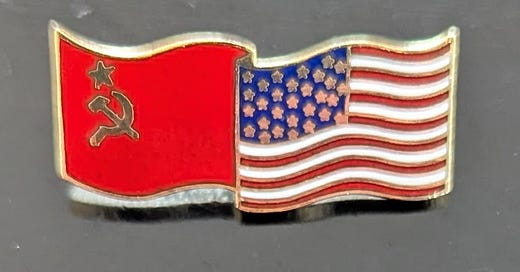The US and Russia Could Have Been Real Friends
The story a tiny pin tells of the difference between 1987 and 2025
While fishing around in an old jewelry box yesterday, I found a cache of lapel pins that I’d saved in the late-1980s. They tell a small story of a very different time in the relationship between the United States and Russia.
Back then, I was a young journalist at USA Today – a newspaper barely half a decade old. I was fascinated with news about Mikhail Gorbachev and the “perestroika” reform movement in the USSR. So, in 1987 I volunteered to travel there to report on how things were changing, especially in business and the economy.
Until that point, the USSR had been our Cold War enemy. Only a few US companies did business with the Soviets. Private enterprise was outlawed. The country had state-owned businesses and a black market, and nothing in between. Hardly any Americans traveled there, and if you did, you had to stay in one of a handful of hotels dedicated for Westerners. Credit cards only worked in those hotels or scattered “hard currency” stores that priced goods in dollars – and locals weren’t allowed into those. Once you were inside the Soviet Union, it would be a small miracle if you could make a phone call back to the US. Only a few phone lines led out of the country.
Preparing for my first trip there, at age 27, felt daunting. I had gotten to know some Americans who studied the Soviet Union, and I asked them what to bring to help me get around and break the ice at meetings. I learned that I should bring two kinds of effective “currency”: Marlboro cigarettes, and lapel pins that had something American on them.
Trading pins with newfound foreign friends was a thing in the USSR. A pin handed to a customs agent could prevent a search of your bag. A pin could turn a minor official from dour to affable. A pin could pay for a taxi ride.
Well, in 1987, USA Today had made up a boatload of five-year anniversary pins. Handily, they had “USA” on them. I packed a couple of fistfuls in my bag.
Before the trip, I was put in touch with a young Muscovite named Peter Zapolnov. He spoke English and worked for a Western entity that was starting – amid the political thaw – to import Western newspapers into the USSR. He was going to be my translator, guide and driver.
When I landed at Moscow’s then-shitty airport, Peter was waiting – inside the arrivals area, pre-customs. He walked with me to customs, where a young customs agent, confronted with a rare American visitor, seemed ready to give me a hard time. Peter asked me if I had an American pin with me. I said I did. Peter told me to give it to the agent. I did. The agent grinned widely and waved me through.
One of my main missions on that first trip was to cover a first-ever trade show of American consumer goods in the Soviet Union. In a vast hall in Moscow, companies such as Procter & Gamble set up booths giving locals their first glimpse of made-in-the-USA stuff ranging from deodorant to candy. And everywhere there were pins. The most popular, worn by both American and Soviet attendees, was a metal pin showing side-by-side US and USSR flags.
It can be hard to remember how radical that seemed. It was so optimistic. The pins were a symbol of a budding friendship between two countries that had been estranged from and angry at each other for 40 years.
The pins were also, significantly, a sign of what many Soviets wanted their country to become: more like America.
Soviet citizens were getting a taste of capitalism, and they liked it. They were getting a whiff of free speech, and they liked it. Over the next few years, as the Berlin Wall fell and the Soviet empire crumbled, it seemed that Western civilization had won – not through war, but by being the better system. Eastern Europe and Russia opened their borders and their arms. McDonald’s opened in Moscow. Russian tech startups caught the eye of American investors. Real peace and cooperation seemed possible.
It didn’t last, of course. The transition turned chaotic and lawless. In a power vacuum, Vladimir Putin took charge. Russia didn’t go all the way back to its Soviet-style system, but it turned inward and once again squared off against the West.
Now here we are. The Trump Administration seems to want a new era of friendship between the US and Russia – an era that might invite pins showing US and Russian flags united.
But this feels different. The West has not won. It seems to be losing. The friendship doesn’t have the feel of optimism and openness. It feels cynical and transactional.
My pin once made me happy. Now it seems old-fashioned and naive. What could have been…didn’t happen.
–
If you’re interested in what life was like in Moscow as the Soviet Union came apart and its citizens first tried capitalism, please pick up my novel “Red Bottom Line.” It’s based on my reporting at the time, and is set in Moscow in 1991. As reviewers have noted, it’s a funny and satirical tale along the lines of movies like “Thank You for Smoking” and “The Death of Stalin.”




